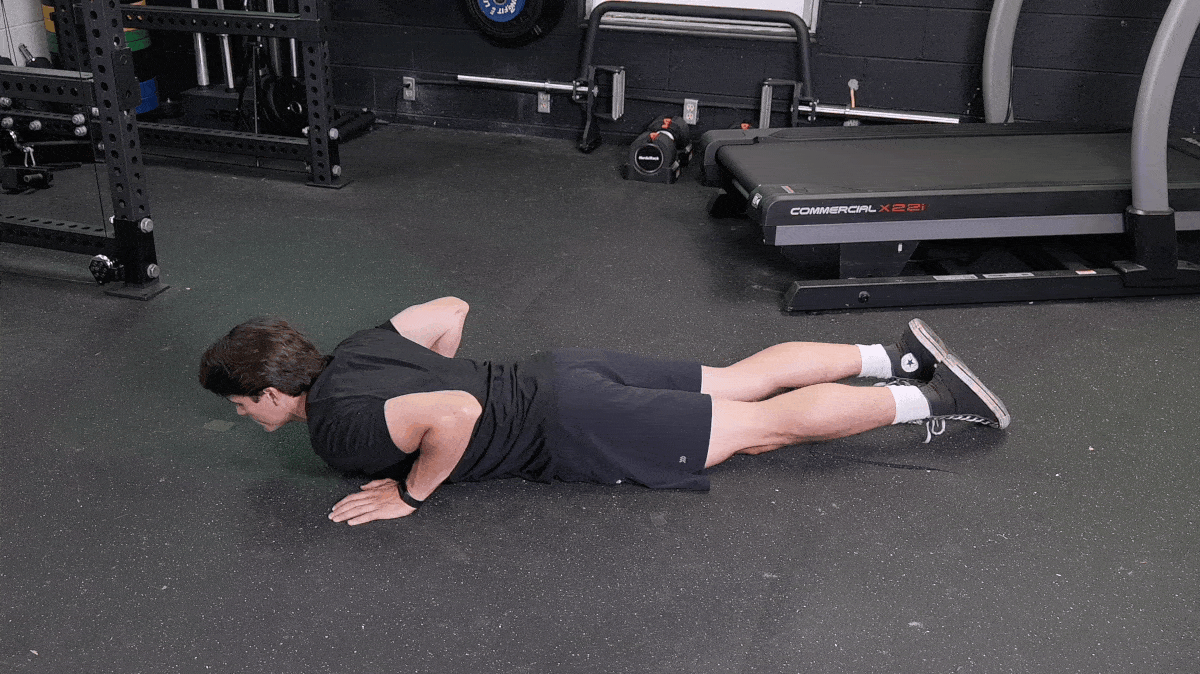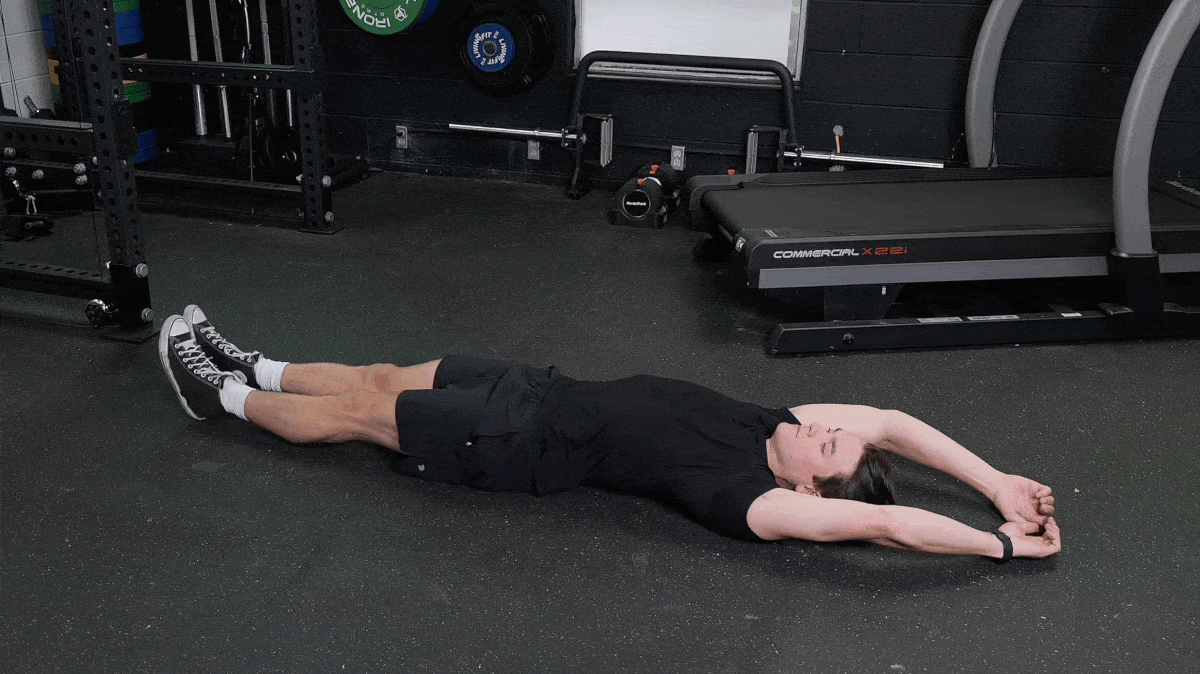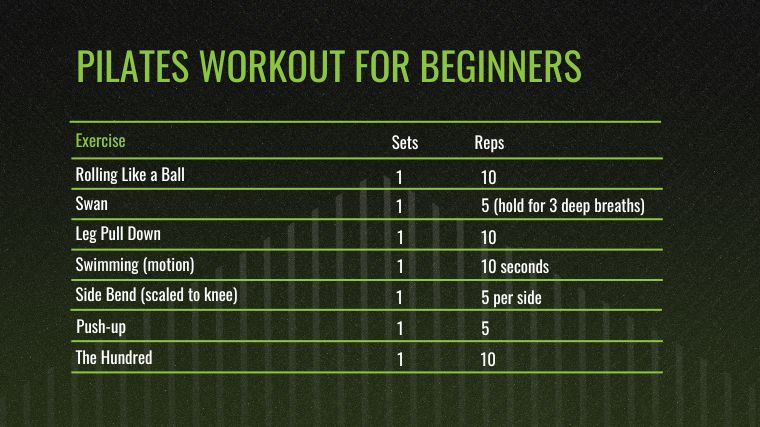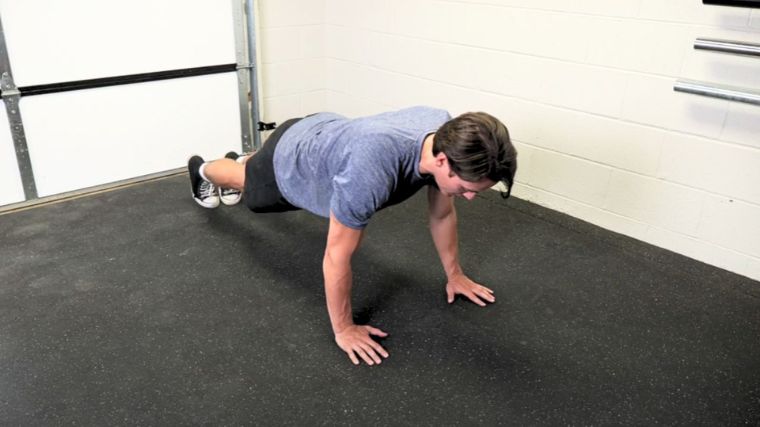You can toss a barbell around like nobody’s business, sure. But how long can you last in a Pilates class?

Pilates is a completely different challenge for most weight room warriors out there. When you’re used to progressively larger and heavier dumbbells, the prospect of a low-impact, no-equipment Pilates workout may seem a bit pedestrian — until you’re in the thick of it. Curious what the fuss is about? Here’s your guide to Pilates for beginners.
What Is Pilates?
Classic Pilates is a bodyweight workout that draws heavily on your core through a long series of exercises. There are two main styles of Pilates that have evolved from the original format created by Joseph Pilates — mat pilates and reformer pilates.
Whichever form you’re using, the core principles of Pilates emphasize control, breathing, and precise movement. In weight room terms, one way to think of this is the mind-muscle connection.
The original Pilates exercises were created in an internment camp during World War I, where incarcerated people could not access most forms of healthy activities or movement, let alone strength training routines. So Pilates exercises require a ton of core strength and coordination, as your own body serves as the resistance. They’re meant to calm both the body and mind.
[Read More: Build Muscle Anywhere With the Best At-Home Bodyweight Workouts]
Pilates as originally conceived is a flow of 34 different exercises that combine for a challenging full-body workout. It has been touted as a great way to alleviate back pain and improve overall muscle awareness and activation.
Of late, various forms of Pilates exercises and workouts have been growing in popularity across different gym boutiques and TikTok alike. Here’s what you need to know to get started on a workout plan including a Pilates-esque approach to your core muscles and overall training.
Pilates Tips for Beginners
Pilates is a great tool for anyone looking to start improving their fitness. It’s low impact and you’re able to perform it on-demand at home or in person at any number of Pilates studios. If you’re just getting started, remember to ease in, start light, emphasize technique, breathe, and enjoy the experience.
Ease In
Like any exercise routine, the first few training sessions are a doozy. Pilates is particularly deceptive as it typically uses no resistance aside from body weight. Even still, the amount of control and tension required to perform the movements leaves you a-trembling by the end of the day.

[Read More: The Best Leg Exercises and Workouts for Stronger Legs]
Take your time with your Pilates workouts. Ease in with even one per week until you learn how it affects your soreness levels and muscle recovery. Depending on your goals, build to as many sessions as you like throughout the week.
Start With Mat Pilates
There’s really no need to dive off the deep end into reformer Pilates. Start with the more beginner-friendly mat Pilates instead. You won’t need special equipment and can get your body used to the rigors of this exercise approach with a series of at-home Pilates beginner workouts.
Why start on the mat? Well, a Pilates reformer is a machine that adds a lot of challenge and more dynamic movement to your Pilates flow. While it is a part of the overall Pilates experience, give yourself some time to build toward fluency with the bodyweight-only exercises first.
Emphasize Technique
One of the core tenets of Pilates is control and precision of movement. A deep connection to your own body and intentional muscle contractions are another way of thinking about the mind-muscle connection. Pilates in general places a huge emphasis on technique to get the absolute most out of each workout.
[Read More: Your Complete Guide to Bodyweight Training]
Since there is low to no resistance — depending on if you’re engaging in mat or reformer Pilates — technique is always paramount. With the amount of core engagement and full body coordination required to successfully pull off a Pilates flow, always start with technique as your main priority.
Focus on Breathing
Breathing is crucial for a good Pilates workout, not only because it helps keep you centered and focused, but also because it’s hard! Pilates demands a ton from your midsection and in doing so also risks interrupting your normal breathing pattern.
As you move from exercise to exercise, remember to stay on top of your breathing. To help maintain good form and tight contractions, try to pair exhalation with contraction and inhalation with the lowering portion of each move. Focus on expanding your belly with each deep, slow breath throughout even the hardest portions of your work.
Work Hard, but Relax
OK, so this one sounds counterintuitive. But once you start, you’ll likely get the idea.
Pilates is a mind-body style of training. The deep emphasis on core, breath, and intentional movement makes it the perfect way to train your entire body while also delivering a truly relaxing experience.
[Read More: The Best Exercise Balls For Beginners, Budget, And More]
At the end of the day, Pilates (and all forms of exercise, for that matter) should deliver you a ton of feel-good endorphins. Work hard on perfecting your technique, breathing, and control, but remember to indulge in the mind-body relaxation aspects, as well.
People say of yoga that it’s “a yoga practice, not a yoga perfect.” And while Pilates is a very different activity, the same principle applies here. Focus on what you’re doing, not on what you look like you’re doing, so that you can really focus on the whole relaxation rather than “perfection” bit.
Sample Pilates Workout for Beginners
Even gentle Pilates is a great way to introduce yourself to bodyweight-focused resistance training. Calisthenics like mat pilates set the stage for all the essential skills and abilities that transfer across any training medium in your future — yes, even HIIT (high-intensity interval training) workouts.
If you’re a beginner, select some of the more forgiving positions and use easier transitions to get the proverbial ball rolling.
The Workout
A traditional Pilates workout follows a flow of up to 34 different exercises. Originally, Pilates workouts were meant to be performed in a specific order and include all positions. However, with a little creative liberty and amendments for beginners, here is a gentler flow to get started.

- Rolling Like a Ball: 1 x 10
- Swan: 1 x 5 (hold for 3 deep breaths)
- Leg Pull Down: 1 x 10
- Swimming (motion): 1 x 10 seconds
- Side Bend (scaled to knee): 1 x 5 per side
- Push-up: 1 x 5
- The Hundred: 1 x 10
Note: Perform 2-4 rounds as a circuit or until your technique starts to break down.
How Often to Do This Workout: A Pilates workout is low impact, but your heart rate may still jump and even feel like some light cardio. Plus, any new training style likely packs a punch. You may feel more sore than anticipated as your body acclimates to the movements. To start, aim for one to three Pilates workouts per week and scale as your workouts become longer or more intense.
[Read More: The Best Bodyweight Bodybuilding Workouts for Gaining Muscle]
Equipment Needed: The beauty of mat pilates is that you do not need any equipment. Just bring your own body weight and you’re all set. For Pilates moves based on a performer, you’ll likely be in a studio with a Pilates instructor.
Modifications
- Make it Easier: Scale exercises such as side bends and push-ups to your knees as necessary. Also, try taking breaks between exercises or even use a rest-pause style set if needed.
- Make it Harder: Aim to complete the full circuit without breaks, and add pauses in the most difficult positions of each exercise. For example, hold each limb for a brief pause while fully contracting on each stride of your swimming exercise.
Benefits of Pilates
Having a Pilates practice offers a mix of both physical and psychological benefits. It’s one of the most commonly referenced training styles for low back pain, has mind-body implications on mental health, is accessible through the life cycle, and has been shown to help manage blood pressure.
It Might Alleviate Low Back Pain
Pilates is known for targeting the core musculature and being low-impact at the same time. The combination of abdominal strength and coordination with no added dumbbells or barbells makes it particularly alluring to those struggling with low back pain.
[Read More: The Biggest Benefits of Pilates, Explained By a Pilates Instructor]
A systematic review with network analysis compared numerous training styles to help determine the best option for improving chronic low back pain. Core control exercise appears to be a solid choice when it comes to managing long-term back pain, with the most beneficial programs involving Pilates. (1)
It Can Boost Your Mental Health
Mind-body benefits are some of the most attractive aspects of Pilates. Physical exercise is a common recommendation for any number of physical or mental health struggles, and Pilates fits the bill nicely.
A randomized control trial investigated the benefits of Pilates on quality of life, anxiety, and depression. Eight weeks of 60-minute Pilates sessions performed three times per week was shown to positively benefit participants — so this appears to be a viable strategy to help manage mental health. (2)
It’s Relatively Accessible
Aging is a scary prospect for many lifters. The loss of mobility or physical abilities to manage everyday life is a daunting prospect. Resistance training and physical activity are the major keys to retaining function, but full gym access may not be in the cards for everyone.

[Read More: One-Month Push-Up Workout Plan for More Push-Ups]
Pilates was shown to be beneficial for several key aspects of aging such as dynamic balance, and is an incredibly accessible method of training. (3) Given that it is capable of being performed at your house and with a simple exercise mat, Pilates is a broadly accessible form of movement.
It Can Reduce Blood Pressure
Blood pressure is top of mind for most health-conscious individuals. But even athletes may not know they have it until it’s diagnosed during an annual physical.
Twelve weeks of Pilates training was employed for both hypertensive and normotensive postmenopausal people. The study found that both groups experienced benefits to several blood pressure-related metrics following their experience with Pilates. (4)
Frequently Asked Questions
If Pilates has started to grab your attention, here are some frequently asked questions to keep you moving in the right direction.
How often should a beginner do Pilates?
Beginner Pilates is designed with sustainability in mind. Pilates is one of the most low-impact and accessible styles of training around, but novel training experiences are still challenging. Try your beginner pilates sessions one to three times per week as you get the hang of things.
Is 20 minutes of Pilates a day enough?
Twenty minutes of pilates a day is absolutely enough. Many exercise styles benefit from “micro-dosing” throughout the day, particularly when time is short. A good Pilates flow for 20 minutes is more than enough to build some physical strength and also experience mind-body benefits.
Can I learn Pilates by myself?
With the plethora of resources around, you can certainly become a self-taught Pilates enthusiast. There are tons of great resources to reference, such as physical therapist and Pilates teacher Jessica Valant; excellent communities to join, such as @blackgirlpilates on Instagram; and countless in-person studios available to help you learn.
Is Pilates a good way to lose weight?
Weight loss is always a function of sustainable exercise and sound nutrition for a long period. Pilates is one of the most accessible forms of exercise and certainly is a strong candidate for the exercise side of the equation.
What can I expect in a typical beginner Pilates class?
Beginner Pilates is meant to teach, encourage, and introduce you to a new form of exercise. Expect a challenge as most of the movements are demanding on core strength and coordination, but you’ll also be able to scale where necessary. Overall, be prepared to learn and enjoy yourself without judgment if you’re not able to hold or even get into all the positions without customizations. Talk to your instructor about any questions and concerns before class.
Editor’s Note: The content on BarBend is meant to be informative in nature, but it should not be taken as medical advice. When starting a new training regimen and/or diet, it is always a good idea to consult with a trusted medical professional. We are not a medical resource. The opinions and articles on this site are not intended for use as diagnosis, prevention, and/or treatment of health problems. They are not substitutes for consulting a qualified medical professional.
References
- Fernández-Rodríguez, R., Álvarez-Bueno, C., Cavero-Redondo, I., Torres-Costoso, A., Pozuelo-Carrascosa, D. P., Reina-Gutiérrez, S., Pascual-Morena, C., & Martínez-Vizcaíno, V. (2022). Best Exercise Options for Reducing Pain and Disability in Adults With Chronic Low Back Pain: Pilates, Strength, Core-Based, and Mind-Body. A Network Meta-analysis. The Journal of orthopaedic and sports physical therapy, 52(8), 505–521.
- Vancini, R. L., Rayes, A. B. R., Lira, C. A. B., Sarro, K. J., & Andrade, M. S. (2017). Pilates and aerobic training improve levels of depression, anxiety and quality of life in overweight and obese individuals. Arquivos de neuro-psiquiatria, 75(12), 850–857.
- Pereira, M. J., Mendes, R., Mendes, R. S., Martins, F., Gomes, R., Gama, J., Dias, G., & Castro, M. A. (2022). Benefits of Pilates in the Elderly Population: A Systematic Review and Meta-Analysis. European journal of investigation in health, psychology and education, 12(3), 236–268.
- Batista, J. P., Tavares, J. B., Gonçalves, L. F., de Souza, T. C. F., Mariano, I. M., Amaral, A. L., Rodrigues, M. L., Matias, L. A. S., Magalhães Resende, A. P., & Puga, G. M. (2022). Mat Pilates training reduces blood pressure in both well-controlled hypertensive and normotensive postmenopausal women: a controlled clinical trial study. Clinical and experimental hypertension (New York, N.Y. : 1993), 44(6), 548–556.